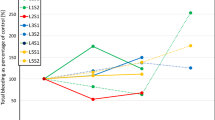Abstract
Superabsorbent polymers (SAP) can be used to control air void formation in concrete. However, due to surfactant left on suspension polymerized SAP particles during production, they may not only create SAP voids but also entrain extra air. In the present investigation, a method is tested to remove surfactant prior to concrete mixing. The method comprises rinsing of the SAP with ethanol. This effectively removes the surfactant. Freeze–thaw testing of concrete with rinsed and non-rinsed SAP shows that for equal dosages of SAP, the extra air entrained due to surfactant is considerable and can make the difference between poor and satisfactory frost-resistance. Furthermore, the results indicate that voids created directly by SAP protect concrete against frost deterioration just like other air voids; if the concrete contains enough SAP voids, these alone can provide sufficient frost resistance.











Similar content being viewed by others
References
Litvan GG, Sereda PJ (1978) Particulate admixture for enhanced freeze–thaw resistance of concrete. Cem Concr Res 8:53–60
Jensen OM, Hansen PF (2001) Water-entrained cement-based materials: I. Principles and theoretical background. Cem Concr Res 31:647–654
Mönnig S, Lura P (2007) Superabsorbent polymers – An additive to increase freeze-thaw resistance of high strength concrete. Adv Constr Mater Part V:351-358
Reinhardt H-W, Assmann A, Mönnig S (2008) Superabsorbent polymers (SAPs)—an admixture to increase the durability of concrete. In: Sun W, Breugel Kv, Miao C, Ye G, Chen H (eds) Microstructure related durability of cementitious composites, RILEM Proceedings PRO 61, pp 313–322
Laustsen S, Hasholt MT, Jensen OM (2008) A new technology for air-entrainment of concrete. In: Sun W, Breugel Kv, Miao C, Ye G, Chen H (eds) Microstructure related durability of cementitious composites, RILEM Proceedings PRO 61, pp 1223–1230
Laustsen S, Møller AM (2007) Kontrolleret luftindblanding i beton (in Danish). Technical University of Denmark, Master thesis
Dudziak L, Mechtcherine V (2010) Enhancing early-age resistance to cracking in high-strength cement-based materials by means of internal curing using super absorbent polymers. In: Brameshuber W (ed) Additions improving properties of concrete, RILEM Proceedings PRO 77, pp 129–139
Laustsen S (2011) Engineered air-entrainment of concrete—Use of superabsorbent polymers. Ph.D. thesis, Technical University of Denmark
Dodson VH (1990) Concrete admixtures. Van Nostrand Reinhold, New York
Pigeon M, Pleau R (1995) Durability of concrete in cold climates. E & FN Spon, London
Du L, Folliard KJ (2005) Mechanisms of air entrainment in concrete. Cem Concr Res 35:1463–1471
Pigeon M, Marchand J, Pleau R (1996) Frost resistant concrete. Constr Build Mater 10:339–348
Buchholz FL, Graham AT (1998) Modern superabsorbent polymer technology. John Wiley & Sons, New York
Jensen OM, Hansen PF (2001) Water-entrained cement-based materials: II. Experimental observations. Cem Concr Res 32:973–978
Jensen OM (2011) Water absorption of superabsorbent polymers in a cementitious environment. In: Leung C, Wan KT (eds) Advances in Construction Materials through Science and Engineering, RILEM Proceedings PRO 79, pp. 22–35
DS/EN 12350-2 (2002) Testing fresh concrete: Part 2: Slump test. Danish Standard
DS/EN 12350-7 (2002) Testing fresh concrete: Part 7: Air content–pressure methods. Danish Standard
Lura P, Friedemann K, Stallmach F, Mönning S, Wyrzykowski M, Esteves LP (2012) Kinetics of water migration in cement-based systems containing superabsorbent polymers. Chapter 4 in Mechtcherine V, Reinhard H-W (eds) Application of superabsorbent polymers (SAP) in concrete construction. State of the Art Report prepared by RILEM Technical Committee 225-SAP. Springer, Heidelberg
Laustsen S, Bentz DP, Hasholt MT, Jensen OM (2010) CT measurements of SAP voids in concrete. In Jensen OM, Hasholt MT, Laustsen S (eds) Use of superabsorbent polymers and other new additives in concrete, RILEM Proceedings PRO 74, pp 153–162
DS/EN 480-11 (2005) Admixtures for concrete, mortar and grout—Test methods—Part 11: Determination of air void characteristics in hardened concrete. Danish Standard
DS/EN 12390-3 (2006) Testing hardend concrete—Part 3: Compressive strength of test specimens. Danish Standard
Hasholt MT, Jensen OM, Kovler K, Zhutovsky S (2012) Can superabsorbent polymers mitigate autogenous shrinkage of internally cured concrete without compromising the strength? Constr Build Mater 31:226–230
DS/CEN/TS 12390-9 (2006) Testing hardened concrete—Part 9: Freeze–thaw resistance—Scaling, Danish Standard
DS 2426 (2011) Concrete—Materials—Rules for application of EN 206-1 in Denmark. Danish Standard
Author information
Authors and Affiliations
Corresponding author
Rights and permissions
About this article
Cite this article
Laustsen, S., Hasholt, M.T. & Jensen, O.M. Void structure of concrete with superabsorbent polymers and its relation to frost resistance of concrete. Mater Struct 48, 357–368 (2015). https://doi.org/10.1617/s11527-013-0188-0
Received:
Accepted:
Published:
Issue Date:
DOI: https://doi.org/10.1617/s11527-013-0188-0




